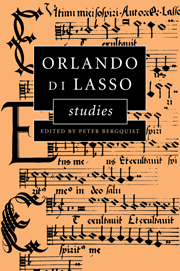Book contents
- Frontmatter
- Contents
- Preface
- List of abbreviations
- 1 Aspects of form in Orlando di Lasso's Magnificat settings
- 2 Orlando di Lasso and Andrea Gabrieli: two motets and their masses in a Munich choir book from 1564–65
- 3 Post-Tridentine liturgical change and functional music: Lasso's cycle of polyphonic Latin hymns
- 4 The salon as marketplace in the 1550s: patrons and collectors of Lasso's secular music
- 5 Lasso's “Standomi un giorno” and the canzone in the mid-sixteenth century
- 6 Lasso's “Fertur in conviviis”: on the history of its text and transmission
- 7 Orlando di Lasso and Rome: personal contacts and musical influences
- 8 Orlando di Lasso as a model for composition as seen in the three-voice motets of Jean de Castro
- 9 The madrigal book of Jean Turnhout (1589) and its relationship to Lasso
- 10 Modal ordering within Orlando di Lasso's publications
- 11 Correct and incorrect accentuation in Lasso's music: on the implied dependence on the text in classical vocal polyphony
- General index
- Index of Lasso compositions and printed sources
9 - The madrigal book of Jean Turnhout (1589) and its relationship to Lasso
Published online by Cambridge University Press: 18 December 2009
- Frontmatter
- Contents
- Preface
- List of abbreviations
- 1 Aspects of form in Orlando di Lasso's Magnificat settings
- 2 Orlando di Lasso and Andrea Gabrieli: two motets and their masses in a Munich choir book from 1564–65
- 3 Post-Tridentine liturgical change and functional music: Lasso's cycle of polyphonic Latin hymns
- 4 The salon as marketplace in the 1550s: patrons and collectors of Lasso's secular music
- 5 Lasso's “Standomi un giorno” and the canzone in the mid-sixteenth century
- 6 Lasso's “Fertur in conviviis”: on the history of its text and transmission
- 7 Orlando di Lasso and Rome: personal contacts and musical influences
- 8 Orlando di Lasso as a model for composition as seen in the three-voice motets of Jean de Castro
- 9 The madrigal book of Jean Turnhout (1589) and its relationship to Lasso
- 10 Modal ordering within Orlando di Lasso's publications
- 11 Correct and incorrect accentuation in Lasso's music: on the implied dependence on the text in classical vocal polyphony
- General index
- Index of Lasso compositions and printed sources
Summary
In the course of preparing a study of Lasso's Libro Quarto of five-voice madrigals (1567), my attention was drawn to the Libro Primo de Madrigali a 6 voci of Giovan [Jean, Jan] Turnhout, published in Antwerp in 1589, in which a large number of pieces–half the contents of the book–are settings of texts used by Lasso. One Netherlandish composer turning to the work of an older and more famous compatriot, to be sure. That is easily said; but sixteenth-century musicians did not have access to the resources of modern libraries, and the whole question of how madrigalists came upon the texts they set is a far from simple one. Turnhout was not, to judge from this volume, a serious student of Lasso's music; his madrigals are far closer in style to the canzonetta of the 1570s and 1580s than they are to Lasso. A few fleeting allusions tell us none the less that he did see not only the texts but the music of the older composer, and indeed music prints must have been an important source for composers in search of texts to set, even if their purpose was not musical parody. Is there some reason for Turnhout to have seen volumes of Lasso madrigals and to have chosen, or have recommended to him, the texts he set?
- Type
- Chapter
- Information
- Orlando di Lasso Studies , pp. 183 - 202Publisher: Cambridge University PressPrint publication year: 1999

